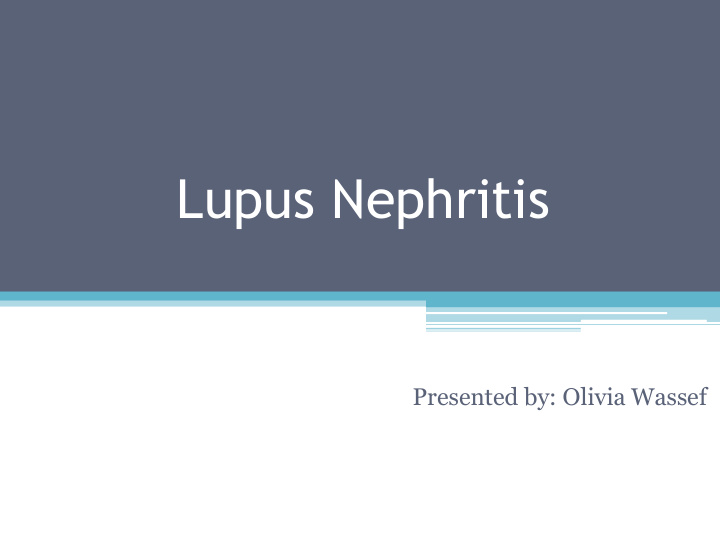



Lupus Nephritis Presented by: Olivia Wassef
What is Systemic Lupus Erythematosus (SLE)? • An Autoimmune Chronic Inflammatory Disease ▫ Immune System produces proteins called autoantibodies that turns against a part of the body it is designed to protect Inflammation Damage. • Lupus can affect joints, skin, heart, blood vessel, kidneys, lungs & brain • It is characterized by periods of illness (flares) & periods of wellness (remissions)
What is Systemic Lupus Erythematosus (SLE )? (Cont’d) • Understanding how to prevent flares & how to treat them when they do occur helps SLE patients maintain better health. • More common in Women; African American & Hispanic & Asian.
What is Lupus Nephritis? • A type of Kidney Inflammation (a common complication of SLE) • It is histologically evident in patients with SLE even if no clinical involvement is yet detected. • Autoantibodies attack glomeruli of kidneys (waste filters) blood in urine (hematuria), Proteins in Urine (proteinuria), high BP & Kidney failure.
Classification of Glomerulonephritis in Lupus As per Kidney Biopsy findings: • Class I disease (Minimal Mesangial LN) NL Urine Analysis & Serum Creatinine concentration • Class II disease (Mesangial Proliferative LN) Microscopic hematuria &/or proteinuria. HTN, Nephrotic Syndrme and renal insufficiency are rare. • Class III disease (Focal LN) Hematuria & proteinuria (most patients). Elevated Cr conc. HTN, Nephrotic syndrome (only some). Progressive renal dysfunction is less common.
Classification of Glomerulonephritis in Lupus (Cont’d) • Class IV disease (Diffuse LN) Hematuria & Proteinuira (in all pts with active LN). Nephrotic Syndrome, HTN & Renal Insufficiency is common. • Class V disease (Lupus Membranous nephropathy) Nephrotic Syndrome mainly. Creatinine level is NL-slightly elevated. • Class VI disease (Advanced Sclerosing Lupus Nephritis) ‘healing of prior inflammatory injury’ slowly progressive renal dysfunction.
Symptoms of Lupus Nephritis • Active SLE symptoms: Brain Persistent headaches, memory loss or confusion. Mouth & Nose Sores Lungs/Heart Shortness of breath, Chest Pain. Fingers/Toes may turn blue/white on cold exposure/stress Fatigue & Unexplained Fever Eyes Dry or puffy Skin Butterfly malar rash on face, worsen with sun exposure. Stomach Nausea, vomiting, recurring Abdominal pain. Bladder Persistent Infections and blood in urine. Joints Persistent pain and swelling
Symptoms of Lupus Nephritis (Cont’d) • Asymptomatic Lupus Nephritis detected in Lab results during regular follow up more typical of mesangial or membranous LN • Active Nephritis: Peripheral edema 2ry to HTN or Hypoalbuminemia. • Diffuse Lupus Nephritis: Headache, dizziness, visual disturbances, symptoms of cardiac decompensation
Physical Findings • Focal & Diffuse LN: Generalized Active SLE ▫ Rash ▫ Oral & Nasal Ulcers ▫ Synovitis or Serositis • Active LN ▫ HTN ▫ Peripheral edema ▫ Cardiac decompensation occasionally. • Membranous LN ▫ No HTN ▫ Peripheral edema ▫ Ascites, Pleural & pericardial effusion.
Diagnosis of Lupus Nephritis • Tests Conducted: ▫ Urine Analysis check for Protein, Red Blood Cells, & Cellular casts. ▫ Blood Test Blood Urea Nitrogen <BUN>, Creatinine <Cr>. ▫ Spot Urine Test for protein and Cr concentration. Calculate Urine Albumin/Creatinine Ratio. ▫ 24 hr. urine test for Cr clearance & Protein excretion. ▫ Kidney Biopsy in any pt with clinical/lab evidence to classify disease. • Most common abnormality is Proteinuria (protein in urine) • Hematuria & Proteinuria with or without elevated Creatinine level is observed in most SLE patients.
Diagnosis of Lupus Nephritis (Cont’d) • Lab tests to detect SLE disease Activity: ▫ Antibodies to double stranded DNA (dsDNA) ▫ Complement (C3,C4 & CH50) ▫ Erythrocyte Sedimentation Rate (ESR) ▫ C-reactive protein (CRP)
Treatment of Lupus Nephritis • There is no cure for lupus nephritis. Treatment goals aim to: ▫ Induce remission of the active disease. ▫ Keep the disease from getting worse. ▫ Reduce symptoms (remission). ▫ Avoid the need for dialysis or kidney transplantation. ▫ Maintain remission.
Treatment of Lupus Nephritis (Cont’d) • Diet Alterations (according to HTN & Hyperlipidemia) ▫ Salt Restriction ▫ Restrict Fat Intake ▫ Restrict Protein Intake (if renal function significantly impaired) • Lipid Lowering Therapy ▫ Statins for hyperlipidemia 2ry to Nephrotic Syndrome.
Treatment of Lupus Nephritis (Cont’d) • Corticosteroid Therapy (1 st line of therapy) If the patient has clinically significant renal disease. • Immunosuppressive Agents; Cyclophosphamide, Azathioprine, or Mycophenolate mofetil If pt has aggressive proliferative renal disease or no response to corticosteroids.
Treatment of Lupus Nephritis (Cont’d) • Hydroxychloroquine decreases flare rates (background therapy in all pts unless contraindicated). • Angiotensin Converting Enzyme Inhibitors (ACEIs) & Angiotensin Receptor Blockers (ARBs) ttt HTN (maintain BP below 130/80) and proteinuria in lupus nephritis
Treatment of Lupus Nephritis (Cont’d) • Calcium Supplementation for Osteoporosis 2ry to long term Corticosteroid therapy. • Biphosphonates • Avoid NSAIDs and other drugs that affect renal function. • Avoid Pregnancy during active lupus worsens renal disease & medication are teratogenic. • ESRD, Sclerosis patients unlikely to respond to aggressive therapy focus therapy on extra- renal manifestations & possible kidney transplant.
Treatment of Lupus Nephritis (Cont’d) • Investigational therapies for lupus nephritis & SLE: ▫ Rituxmab ▫ Other anti-CD20 monoclonal antibodies ▫ Belimumab ▫ Atacicept ▫ Abetimus ▫ Anticytokine therapies (monoclonal antibodies directed against interferon alpha, Interleukin 1,6,10 and TNF alpha.
References • Bomback , Andrew S. “Diagnosis & Classification of Renal Disease in Systemic Lupus Erythematosus” UpToDate, 24 Mar.2016m UpToDate.com/store.Accessed 11 Sept 2017. • Lupus nephritis.” Mayo Clinic , Mayo Foundation for Medical Education and Research, 23 Aug. 2017, www.mayoclinic.org/diseases-conditions/lupus- nephritis/lupus-nephritis-care-at-mayo-clinic/ovc- 20236614. Accessed 13 Sept. 2017. • Lupus Nephritis.” Practice Essentials, Background, Pathophysiology , 27 June 2017, emedicine.medscape.com/article/330369-overview. Accessed 13 Sept. 2017
Recommend
More recommend